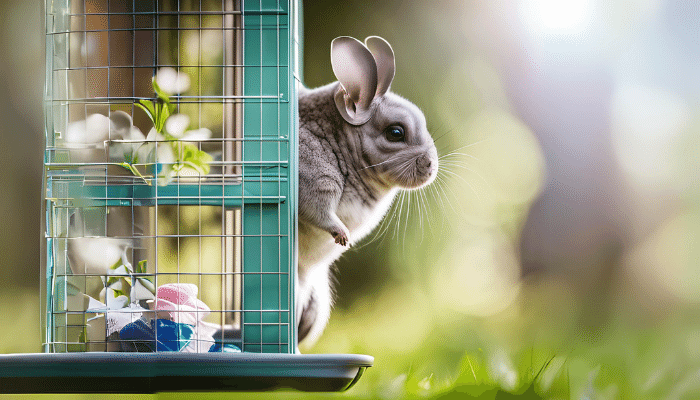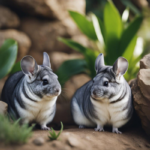Living with a chinchilla is akin to having a tiny companion in your home. These adorable creatures communicate through a surprisingly diverse range of vocalizations. But what do these sounds mean? How can you understand its mood?
This guide will equip you with the knowledge to translate your furry friend’s language and deepen your bond.
Chinchilla Vocalizations

Unlike some rodents, chinchillas are not known for their silence. Their vocal repertoire is surprisingly rich and complex, encompassing a variety of sounds with distinct meanings. Let’s delve into the most common chinchilla vocalizations.
Coos: These soft, high-pitched sounds are the hallmark of a happy chinchilla. Imagine a tiny bird chirping contentedly that’s the sweet melody of a cooing chinchilla. It’s often used during playtime, grooming, or when feeling safe and secure.
Trills: Similar to coos, trills are another indicator of happiness and contentment. Imagine a canary singing a joyful tune that’s the essence of a trill. Chinchillas might trill while exploring their cage, enjoying a dust bath, or munching on their favourite treats.
Grunts: These low, rumbling sounds can be a bit ambiguous, depending on the context. Soft, gentle grunts are often a sign of contentment and relaxation, like a contented sigh. However, louder, more abrupt grunts can indicate displeasure or warning, especially if accompanied by puffed fur or tail flicking.
Squeaks: Squeaks are a versatile vocalization, used in various situations. Short, high-pitched squeaks can be a sign of excitement or curiosity, like a child’s surprised yelp. Longer, more drawn-out squeaks can indicate discomfort or fear, like a whimper. Pay attention to the pitch and duration of the squeak to understand the underlying emotion.
Barks: These loud, sharp barks are a clear warning sign. If your chinchilla barks, it’s feeling threatened or scared. This might happen if you try to pick it up when it’s not in the mood, introduce a new pet, or expose it to loud noises. Respect your chinchilla’s boundaries and give it space when it barks.
Beyond the Basics

While these are the most common vocalizations, chinchillas have a few other tricks up their furry sleeves:
Dust Whistles: When chinchillas take a dust bath, they might emit a high-pitched whistle. This is thought to be a communication signal to other chinchillas, indicating their location and enjoyment of the dust.
Clicking: Some chinchillas make a clicking sound with their teeth. This is usually a sign of contentment and relaxation, similar to a purring cat.
Growls: Deep, guttural growls are a rare but alarming sound. They indicate extreme fear or aggression and should be taken seriously. If your chinchilla growls, it’s best to leave it alone and try to identify the source of its distress.
Pro Tip: If your chinchilla is chirping when you enter the room, they’re likely expressing their delight at seeing you.
Understanding Your Chinchilla

Learning to interpret your chinchilla’s vocalizations is key to building a strong bond and ensuring its well-being. Pay attention to the sound itself, the context in which it occurs, and your chinchilla’s body language. A combination of these factors will help you accurately decipher its mood.
Vocalizations are not always clear cut: Some sounds can have different meanings depending on the context. Observe your chinchilla’s behaviour and overall demeanour to understand the message.
Body language is key: Pay attention to your chinchilla’s posture, tail movement, and fur texture. These visual cues can provide valuable clues about its emotional state.
Be patient and consistent: It takes time and observation to learn your chinchilla’s unique language. Be patient, and consistent in your interactions, and build trust with your furry friend.
The Vocal Spectrum

Chinchilla vocalizations span a broad spectrum, and each pitch conveys a specific message. Understanding this range is key to interpreting your furry friend’s emotional state and needs.
High Pitched Tunes
High-pitched vocalizations often indicate excitement, curiosity, or even a bit of mischief. It’s the chinchilla’s way of expressing enthusiasm, much like a joyful song.
Low Tone Mumbles
On the flip side, low-toned mumbles can signal relaxation or a desire for solitude. These hushed vocalizations are a part of the chinchilla’s subtle communication when winding down.
Chinchilla Vocalizations in Context

To truly grasp the nuances of Chinchilla Vocalizations, it’s essential to observe your chinchilla in different situations. Here’s a quick guide to interpreting vocalizations in specific contexts:
During Playtime
Chinchillas often express joy through chirps during playtime. Observe the frequency and pitch to gauge your pet’s excitement level.
In the Presence of Other Chinchillas
When chinchillas interact, they may use a combination of chirps and barks. Pay attention to these interactions to understand their social dynamics.
In Unfamiliar Environments
Squeaks and barks in unfamiliar surroundings might indicate anxiety. Gradually introduce your chinchilla to new environments to minimize stress.
Conclusion
Owning a chinchilla is an adventure in deciphering the language of adorable squeaks and chirps. By learning to interpret these vocalizations and observing body language, you can embark on a journey of deeper understanding and connection with your furry friend. So, listen closely, translate patiently, and enjoy the symphony of your chinchilla’s unique song.
Unravel the mysteries of Chinchilla Vocalizations, and you’ll discover a world where every sound tells a tale, enriching the shared narrative of humans and chinchillas. Embrace the symphony, cherish the moments, and let the language of vocalizations strengthen the connection with your fluffy friend.
Bonus Tip: Record your chinchilla’s vocalizations and try identifying them later. This can be a fun activity and a great way to hone your chinchilla-whisperer skills!
FAQs

Why do chinchillas make noise at night?
Chinchillas are crepuscular, meaning they are most active during dawn and dusk. Nocturnal sounds, like barks, serve as a communication tool, helping them navigate their surroundings in the dark.
Do chinchillas vocalize when in pain?
Yes, chinchillas may vocalize when in distress or pain. Listen for unusual sounds like high-pitched squeaks or persistent barks, which could indicate discomfort.
Can chinchillas mimic human speech?
While chinchillas are not adept mimics, they may pick up on certain sounds in their environment. However, expecting them to recite Shakespeare might be a tad ambitious.
How can I encourage vocalizations in my chinchilla?
Creating a stimulating environment with toys and social interactions can encourage chinchillas to express themselves. Pay attention to their cues and respond accordingly.
Is excessive vocalization a cause for concern?
While chinchillas are naturally vocal, sudden changes or incessant noise could be a sign of stress or health issues. Regular veterinary check-ups and a cozy, stress-free environment are key.
Do all chinchillas make the same vocalizations?
While there are commonalities, each chinchilla has its unique vocal repertoire. Pay attention to your chinchilla’s specific sounds to understand its individual language.
How can I tell if my chinchilla is scared?
A scared chinchilla will often emit a high-pitched, drawn-out squeak as well as display physical signs like flattened ears, puffed fur, and tail flicking. If you notice these cues, identify the source of their fear and remove it or give them space to calm down.










